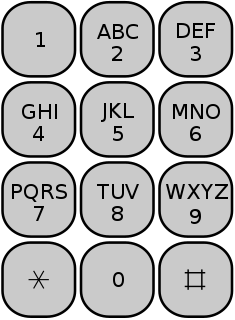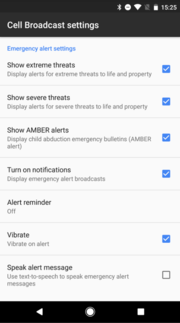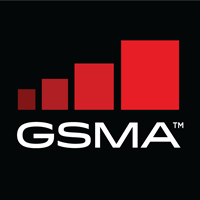
Country codes are short alphabetic or numeric geographical codes (geocodes) developed to represent countries and dependent areas, for use in data processing and communications. Several different systems have been developed to do this. The term country code frequently refers to international dialing codes, the E.164 country calling codes.
General Packet Radio Service (GPRS) is a packet oriented mobile data standard on the 2G and 3G cellular communication network's global system for mobile communications (GSM). GPRS was established by European Telecommunications Standards Institute (ETSI) in response to the earlier CDPD and i-mode packet-switched cellular technologies. It is now maintained by the 3rd Generation Partnership Project (3GPP).

SMS is a text messaging service component of most telephone, internet, and mobile-device systems. It uses standardized communication protocols to enable mobile devices to exchange short text messages. An intermediary service can facilitate a text-to-voice conversion to be sent to landlines. SMS was the most widely used data application, with an estimated 3.5 billion active users, or about 80% of all mobile subscribers, at the end of 2010.
The Universal Mobile Telecommunications System (UMTS) is a third generation mobile cellular system for networks based on the GSM standard. Developed and maintained by the 3GPP, UMTS is a component of the International Telecommunications Union IMT-2000 standard set and compares with the CDMA2000 standard set for networks based on the competing cdmaOne technology. UMTS uses wideband code division multiple access (W-CDMA) radio access technology to offer greater spectral efficiency and bandwidth to mobile network operators.
The international mobile subscriber identity or IMSI is used to identify the user of a cellular network and is a unique identification associated with all cellular networks. It is stored as a 64 bit field and is sent by the phone to the network. It is also used for acquiring other details of the mobile in the home location register (HLR) or as locally copied in the visitor location register. To prevent eavesdroppers identifying and tracking the subscriber on the radio interface, the IMSI is sent as rarely as possible and a randomly generated TMSI is sent instead.

A subscriber identity module or subscriber identification module (SIM), widely known as a SIM card, is an integrated circuit that is intended to securely store the international mobile subscriber identity (IMSI) number and its related key, which are used to identify and authenticate subscribers on mobile telephony devices. It is also possible to store contact information on many SIM cards. SIM cards are always used on GSM phones; for CDMA phones, they are only needed for newer LTE-capable handsets. SIM cards can also be used in satellite phones, smart watches, computers, or cameras.

Near-field communication (NFC) is a set of communication protocols that enable two electronic devices, one of which is usually a portable device such as a smartphone, to establish communication by bringing them within 4 cm (1.6 in) of each other.
The International Mobile Equipment Identity or IMEI is a number, usually unique, to identify 3GPP and iDEN mobile phones, as well as some satellite phones. It is usually found printed inside the battery compartment of the phone, but can also be displayed on-screen on most phones by entering *#06# on the dialpad, or alongside other system information in the settings menu on smartphone operating systems.
Network switching subsystem (NSS) is the component of a GSM system that carries out call out and mobility management functions for mobile phones roaming on the network of base stations. It is owned and deployed by mobile phone operators and allows mobile devices to communicate with each other and telephones in the wider public switched telephone network (PSTN). The architecture contains specific features and functions which are needed because the phones are not fixed in one location.
A mobile virtual network operator (MVNO), virtual network operator (VNO), or mobile other licensed operator (MOLO), is a wireless communications services provider that does not own the wireless network infrastructure over which it provides services to its customers. An MVNO enters into a business agreement with a mobile network operator to obtain bulk access to network services at wholesale rates, then sets retail prices independently. An MVNO may use its own customer service, billing support systems, marketing, and sales personnel, or it could employ the services of a mobile virtual network enabler (MVNE).
MSISDN is a number uniquely identifying a subscription in a GSM or a UMTS mobile network. Simply put, it is the mapping of the telephone number to the SIM card in a mobile/cellular phone. This abbreviation has several interpretations, the most common one being "Mobile Station International Subscriber Directory Number".

ISO 6346 is an international standard covering the coding, identification and marking of intermodal (shipping) containers used within containerized intermodal freight transport. The standard establishes a visual identification system for every container that includes a unique serial number, the owner, a country code, a size, type and equipment category as well as any operational marks. The standard is managed by the International Container Bureau (BIC).
The Reporting Body Identifier is the first two digits of a Global System for Mobile Communications (GSM) Type Allocation Code, and indicates the GSMA-approved organization that registered a given mobile device, and allocated the model a unique code.

Cell Broadcast/Cell Information (CB) messaging is a mobile technology feature defined by the ETSI’s GSM committee and is part of the 2G, 3G, 4G LTE (telecommunication) and 5G standards. It is also known as Short Message Service-Cell Broadcast (SMS-CB).
Rich Communication Services (RCS) is a communication protocol between mobile-telephone carriers and between phone and carrier, aiming at replacing SMS messages with a text-message system that is richer, provides phonebook polling, and transmit in-call multimedia.

IP exchange or (IPX) is a telecommunications interconnection model for the exchange of IP based traffic between customers of separate mobile and fixed operators as well as other types of service provider, via IP based Network-to-Network Interface. IPX is developed by the GSM Association.
ISO base media file format defines a general structure for time-based multimedia files such as video and audio. The identical text is published as ISO/IEC 15444-12.










